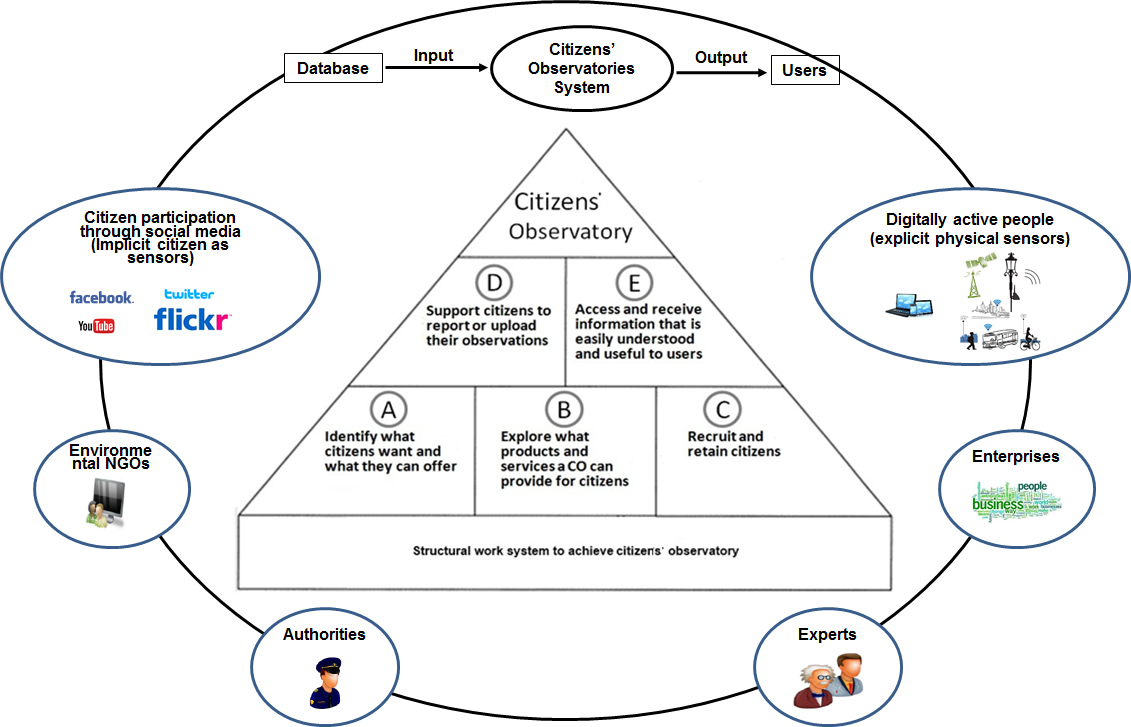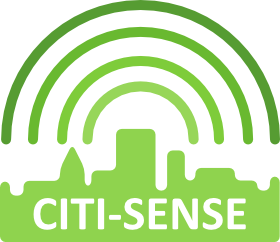What Is Citizens’ Observatories?
There is no clear definition of a Citizens’ Observatory available yet. In a broadest science, a CO for supporting community-based environmental governance can be defined as “the citizens’ own observations and understanding of environmentally related issues and in particular as reporting and commenting on them within a dedicated ICT platform” (Liu et al., 2014). As such, the Citizens’ Observatory promotes communication and supports the sharing of technological solutions (e.g., sensor and sensor platforms, mobile apps, web portals) and community participatory governance methods (e.g., aided by various social media streams) among citizens. This definition shows three core components that underpin some of its objectives, i.e., raising the citizens’ environmental awareness; enabling dialogue among citizens, scientists and policy- and decision-makers; and supporting data exchange among citizens, scientists and other stakeholders. It also promotes a more active role for the community concerning understanding the environment, since citizens are traditionally considered as consumers of information services at the very end of the information chain and not as data providers.
In CITI-SENSE, Citizens’ Observatory is defined as ‘Communities that share technological solutions, information products and services and community participatory Methods, to complement established environmental data and information systems, improve local environmental decision making‘.
A Common Citizens’ Observatories Model
At present, the concept of Citizens’ Observatory has been implemented in various environmental monitoring fields, e.g., water quality, air pollution, odour, biodiversity, climate change, etc. In practice, all Citizens’ Observatories typically share a similar model, including the main aspects needed to develop the Citizens’ Observatory as a method for data collection. These include engaging citizens’ participation in data collection, data interpretation and information delivery. Alternatively, the Citizens’ Observatory model can be expressed as a combination of:
- Sequential aspects
- Interaction with citizens and other stakeholders
- Data collection tools
- ICT infrastructure that underlie the Citizens’ Observatory framework and support effective citizens’ participation

A set of sequential aspects (central part of Figure) has been identified by Liu et al., 2014 as following: A) Identifying what citizens want and what citizens can offer; B) Exploring what products and services a CO can provide for the citizens; C) Recruiting and retaining citizens to participate in and contribute to environmental governance; D) Providing tools that support citizens to report their observations, inferences and concerns; and E) Supplying tools to access/receive timely information on the environment in a manner that is both easily understood and useful.
The essential aspects of the interaction with citizens and other stakeholders (Circles along the outer open edge of Figure) have been addressed in all existing Citizens’ Observatories models. A Citizens Observagtory includes observations from not just professionals and scientists, but also citizens. An effective Citizens’ Observatory shall enable a two-way communication paradigm between citizens and other stakeholders, potentially resulting in profound changes to local environmental management processes and, as such, engage in social innovation processes and outcomes.
The data collection tools (Two ovals along the outer open edge of Figure) are highlighted in the existing Citizens’ Observatory models as well. Currently, both social media platforms and innovative monitoring technologies (e.g., smartphones, low-cost micro-sensors) are used to engage citizens and to collect data.
The ICT infrastructure (Big oval on the top of Figure) is an essential part of the Citizens’ Observatory model which includes boundary services with sensors and apps, data management services, data storage support, and the reusable visualisation widgets used for both apps and web portals.
Top-down & Bottom-up Approach
Citizens’ Observatories can be seen as a combination of top-down and a multi-layer bottom-up approach. Top-down approaches are typically research-led (expert) and often start with the formulation of visions of future direction. At the same time, a broad variety of bottom-up initiatives are taken by different public groups (citizens) who develop and try out new approaches to meet the challenges as they see them.
In CITI-SENSE, we developed a combined top-down and bottom-up approach which can be interpreted as ‘the use of citizen science as a two-way data connection between the researchers and citizen scientists who work from opposite approaches’. This combined approach creates a platform for exchange of information in two directions, and an involvement and engagement with all stakeholders which is crucial if a sustainable Citizens’ Observatory programme is to take place (Liu et al., 2014) .

In CITI-SENSE practice, the combined top-done and bottom-up approach can be defined by the following: (i) The key components of the top-down Citizens’ Observatories approach includes the definition of the Citizens’ Observatories goals, selecting and applying the necessary standards, protocols, sampling designs and methodologies, wherever these have one identical purpose in various case studies within one environmental domain. (ii) Crucial to the multiple layer bottom-up Citizens’ Observatories approach are heterogeneous data sources that can accommodate multiple data standards, conflicting requirements from diverse user groups and a definite need to develop methodologies that are able to integrate diverse systems and ultimately synthesize data of many types and formats. Together, these two approaches aim to minimize the differences, and maximize what is similar, among multiple systems, enabling both individual case study data analysis and integrated data analysis to be performed.
For more information about Citizens’ Observatories concept, please contact Hai-Ying Liu from NILU via email hyl@nilu.no.
Term of Use
If you use our Citizens’ Observatories concept, please refer it to the article Liu et al., (2014), as well as to the CITI-SENSE project as follows: The Citizens’ Observatories concept was partly developed by the CITI-SENSE project. CITI-SENSE is a Collaborative Project partly funded by the EU FP7-ENV-2012 under grant agreement no. 308524.
Reference:
Liu HY, Kobernus M, Broday D, Bartonova A. 2014. A conceptual approach to a citizens’ observatory–supporting community-based environmental governance. Environmental Health 13 (1), 107.


